Avaya CM - Server Installation
This provides information for the Avaya CM server installation process.
This is a guide to walk you through a new configuration for Xima's Chronicall for Avaya Communication Manager.
Server Requirements
Format
- Downloadable Setup File
Database
- PostgreSQL & OrientDB
Web Server
- Apache Tomcat
User Interface
- Web Interface
- Chronicall Desktop Application
Server Requirements
- Windows 7 or higher, Windows 2008 or higher, Linux 32 or 64 bit
- 250 GB Hard Drive (Minimum)
- 4 - 8 GB Ram
- Quad Core CPU (Minimum)
Note: The chart below shows the amount of RAM required per Realtime Agent Seat.

User PC Requirements
- Windows 7 or higher; 32/64-bit Linux
- Internet Explorer
- Java 7 or newer
- Javascript Enabled
Recording Storage
The following chart details the number of days until the disk drive is filled up from recording. Use this information to determine your company’s needs.
| Memory | 1 Agent | 5 Agents | 10 Agents | 25 Agents | 50 Agents |
|---|---|---|---|---|---|
| 32 GB | 700 | 140 | 70 | 28 | 14 |
| 250 GB | 5,461 | 1,092 | 546 | 218 | 109 |
| 500 GB | 10,922 | 2,185 | 1,092 | 437 | 218 |
| 1000 GB | 21,845 | 4,370 | 2,185 | 875 | 437 |
*Assume 8 hours per agent, per day
VRTX CPU & Server Requirements
SIP Trunk UtilizationIf you are utilizing a SIP trunk, it is recommended (but not required) that a Port Mirror be utilized.
Note: It is recommended that no more than two devices are attached to the Chronicall Server. If more than two VRTX devices are needed, be sure that they are attached to separate, stand-alone servers. Three VRTX devices are supported_per server. If encrypting recordings, additional memory may be needed. Refer to the chart below for memory requirements for the amount of VRTX devices and Recording Ports (RP)_

Avaya Communication Manager
- Release 5.0 or newer
- Avaya CDR, AES Server with Basic TSAPI Licenses
- NOTE: Ensure Agents and Stations do not have matching names, as it is not supported in Chronicall and will not log properly
Avaya Licenses Required
- AES Server with Basic TSAPI Licenses
Summary of Installation
Installing Chronicall for Avaya Communication Manager requires a few simple
configuration changes to your CM server. Do the following to configure your setting previous to installing Chronicall:
- Create login information for Chronicall to use on your CM server.
- Configure CDR services to enable Chronicall to connect and log call events
- Configure your AES server to enable Chronicall to connect and log call events
- Install Chronicall
Section 1.1 – CM Configuration
To configure Avaya CM, do the following:
- Access the CM server and open the Avaya site administration (ASA)
application.
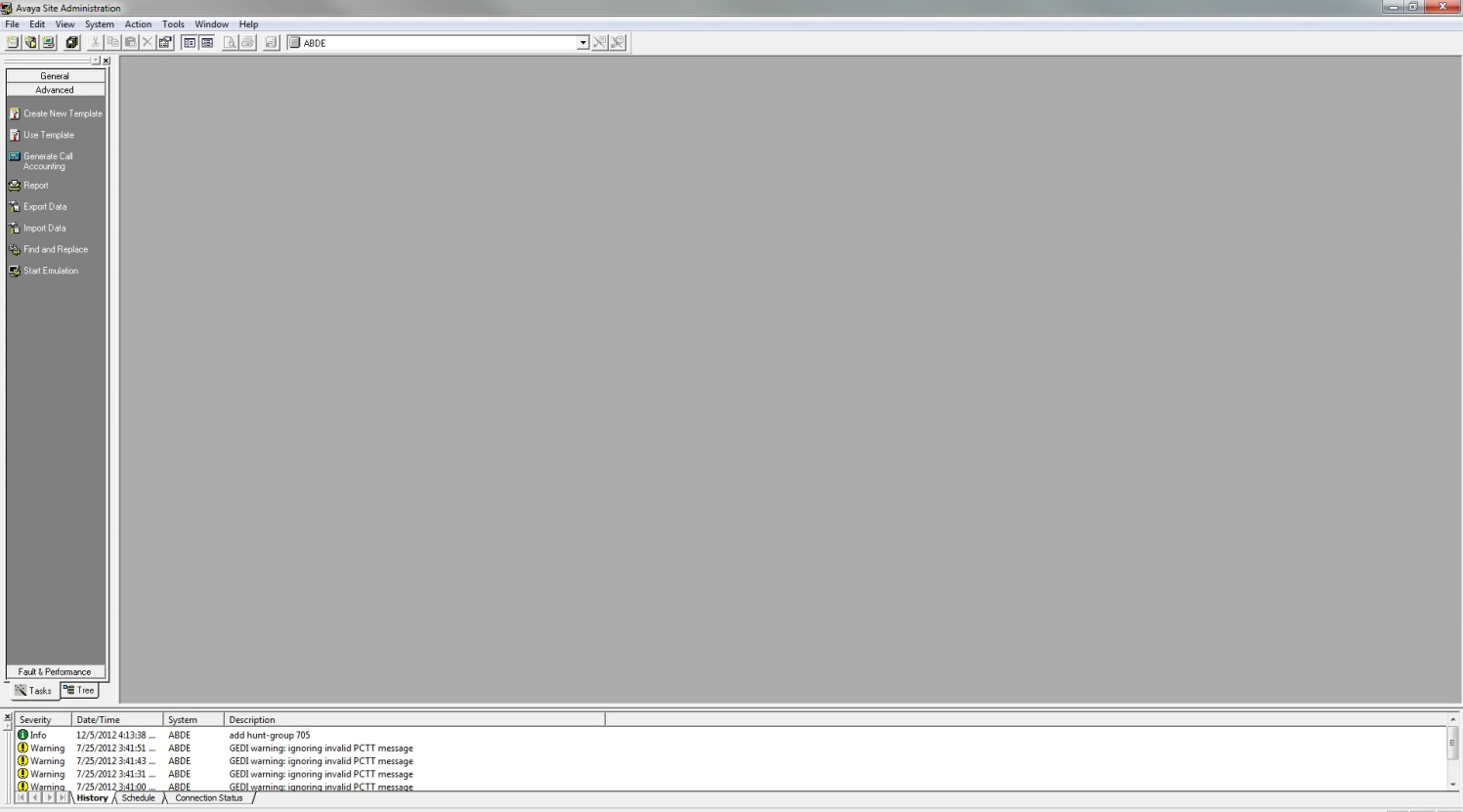
- Add a new Voice System by opening File → New → Voice System. Name this new system
and press Next.
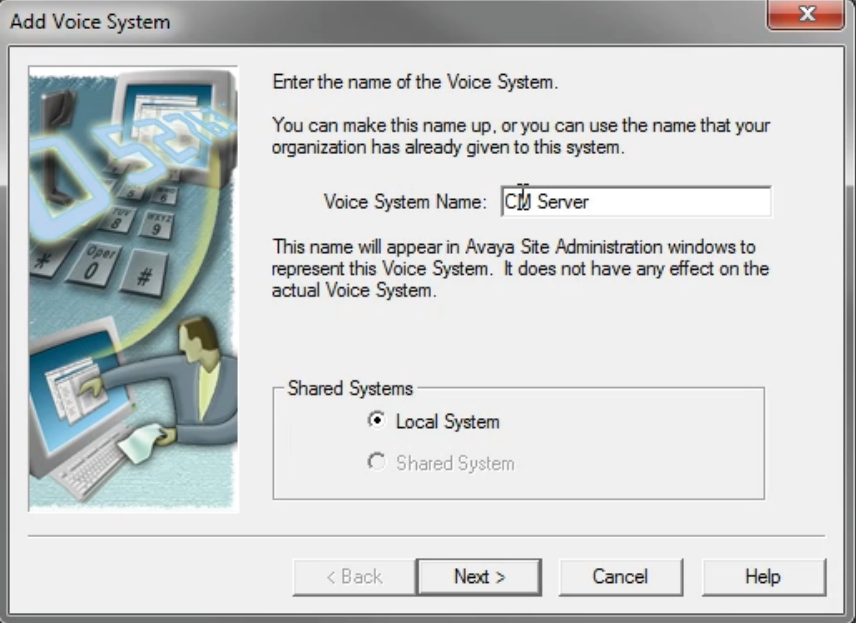
- Make sure that Network Connection is selected, then press Next.
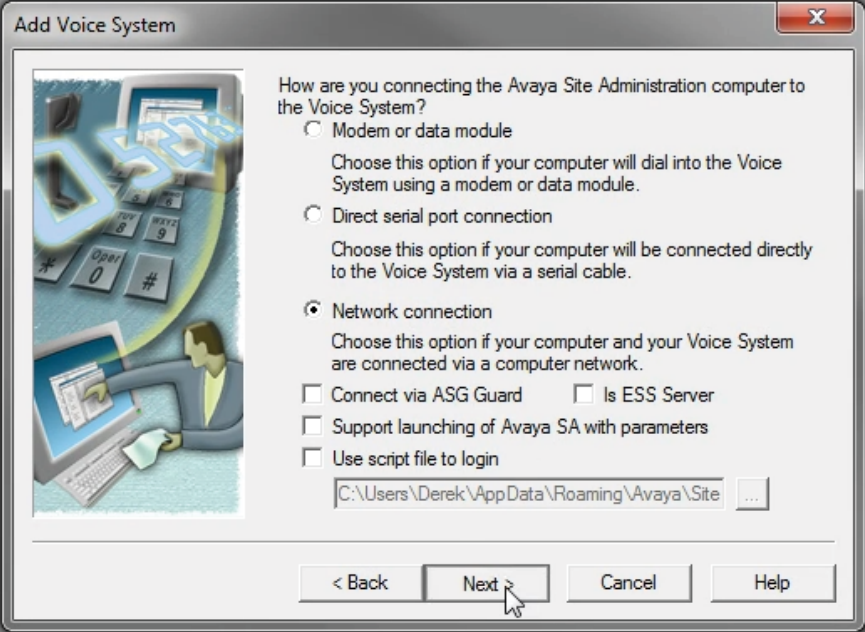
- Accept the default options on the next few screens until you are asked for a login name
and password. Enter the information of a privileged administrator account. Continue moving through the next few screens until the process is complete.
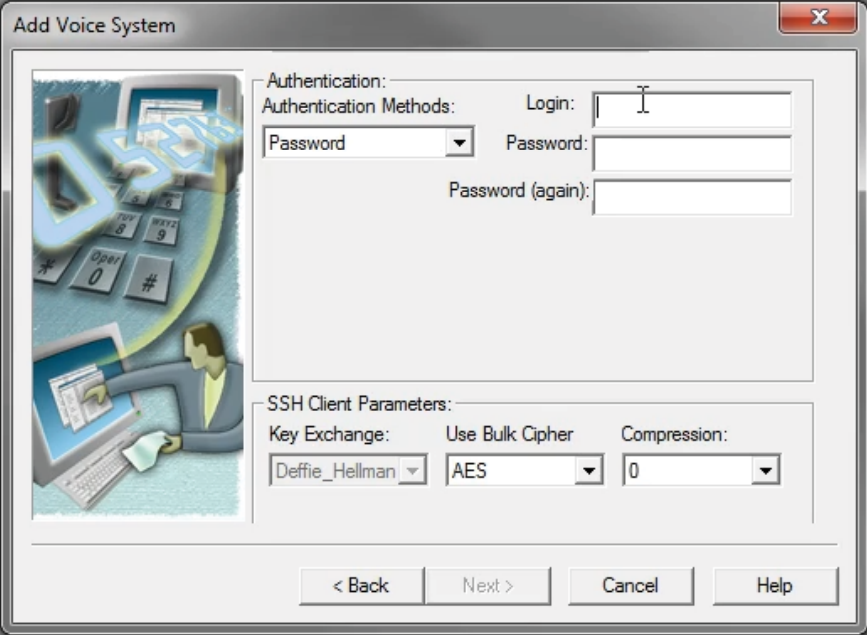
- Once this is finished, click Start Emulation in the advanced section of the sidebar to the left and a blue command screen line with pop up.
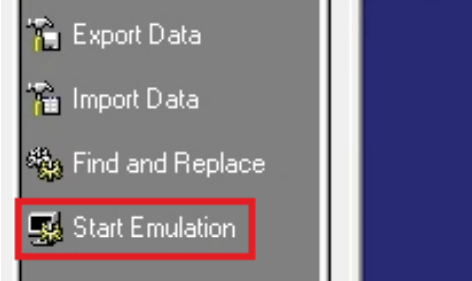
- Create a user profile. This profile will outline Chronicall's access privileges. When you create a user, you will apply this user profile to it.
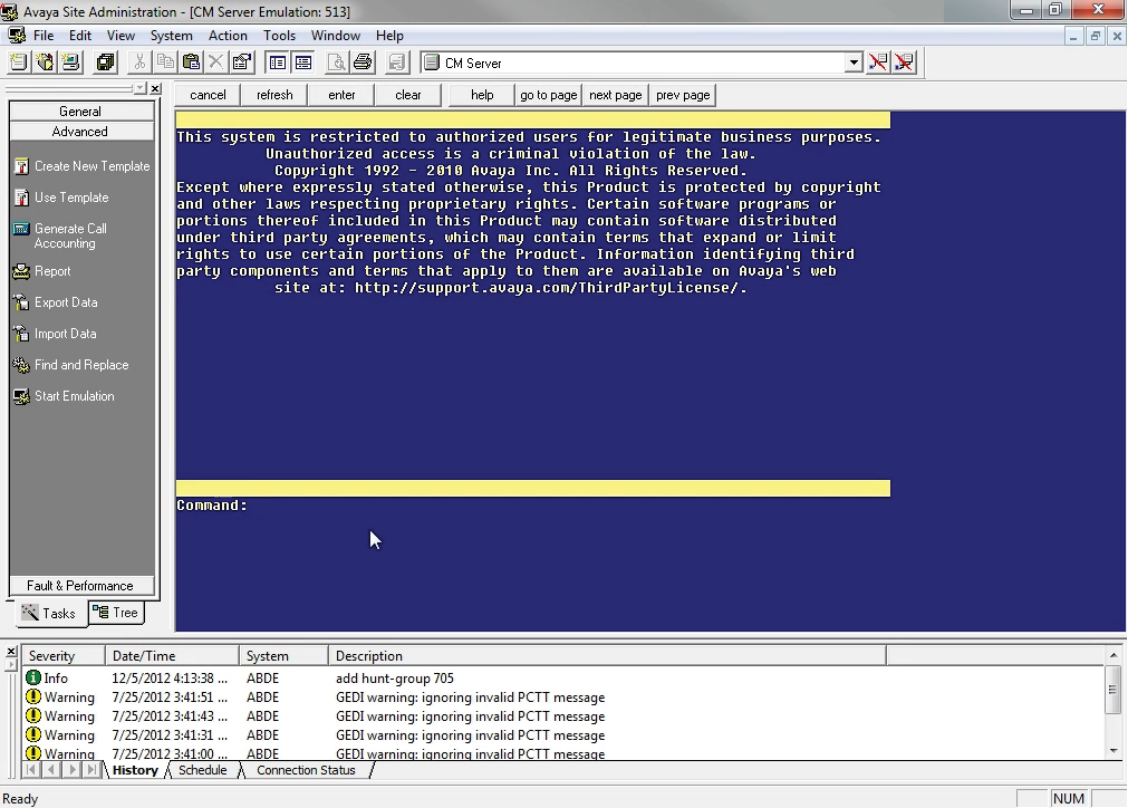
Section 1.2 - Adding a User Profile
To add a user profile, do the following:
- Enter list user-profiles into the command line. This will show you a list of user profiles that currently exist on the system. User profiles 0 through 19 are reserved by the system, so any user profile number you choose will need to be 20 or higher. Once you've chosen a number, enter add user-profile followed by the profile number.
For example, add user-profile 20.
add user-profile 21This will bring up a new user profile screen.
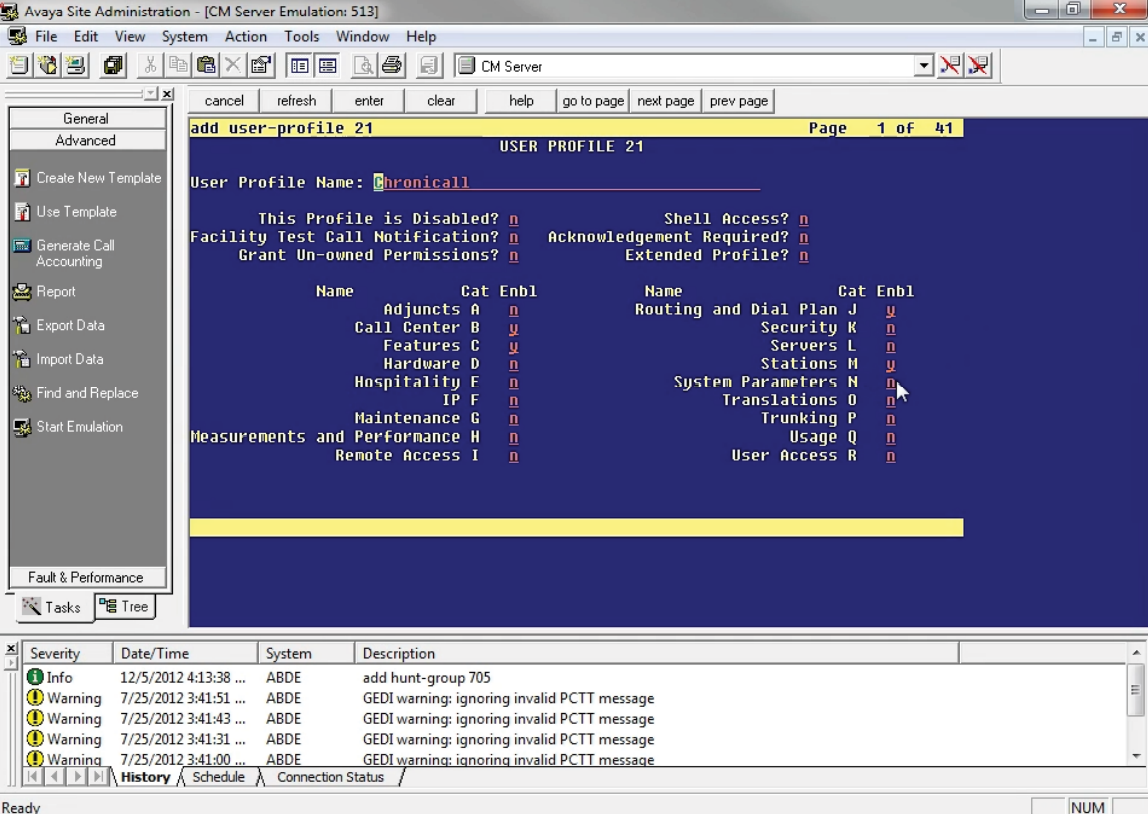
- Enter Chronicall in the User Profile Name field.
- To enable specific permissions for this user profile. Arrow down to the Enable column and change n to y for:
Call Center (B), Features (C), Routing and Dial Plan (J), and Stations (M).
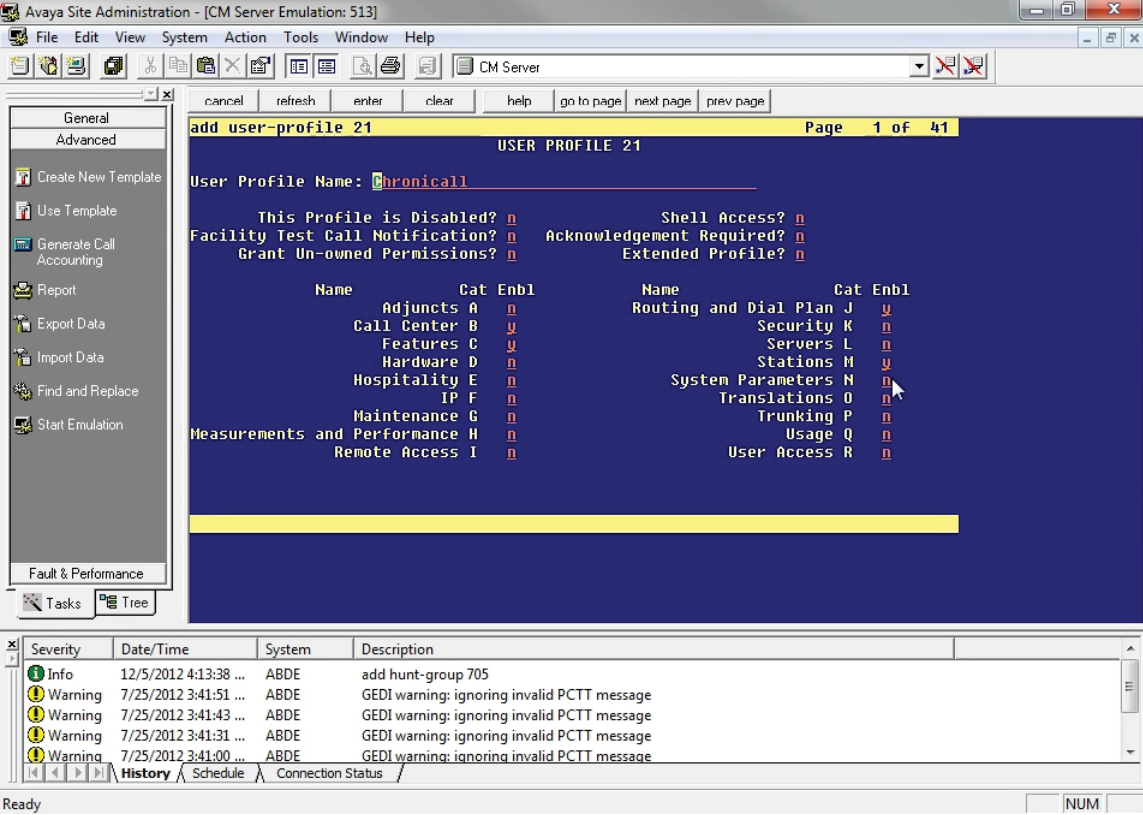
- Move to the next page using Page Down. This section shows specific read and write functions in each of the categories listed before.
- Change the permissions for the categories listed above to --, meaning no access.
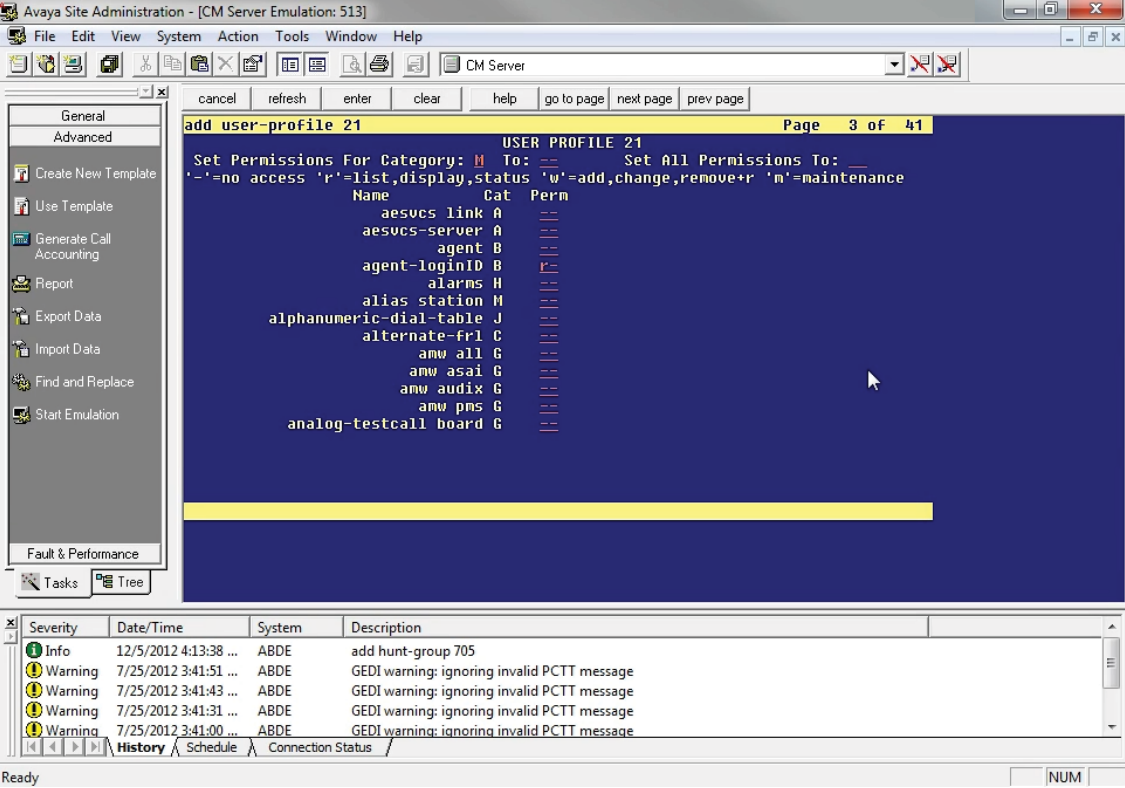
- Give read (r-) access to the following functions:
page 3 agent-loginID
Page 14 hunt-group
Page 31 station
Page 37 uniform-dialplan
Page 39 vdn
Page 39 vector
Once this is finished, click the Enter button at the top of the screen.
- Open your web browser and navigate to https://[CM server IP address] to open the Avaya System Management Interface, or SMI.

- Log in and open the Administration drop-down menu at the top of the page, and click Server (Maintenance).

- Under the Security tab on the left, click Administrator Accounts. This option will only show when logged into this portal as an administrator.
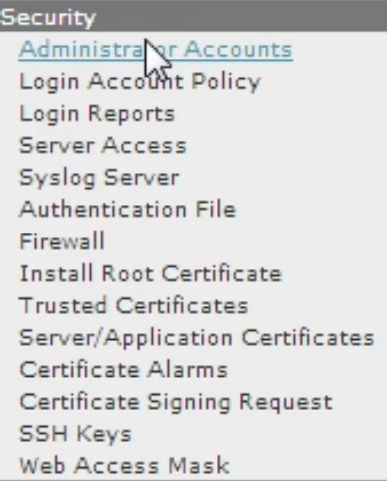
- Choose Add Group and Submit.
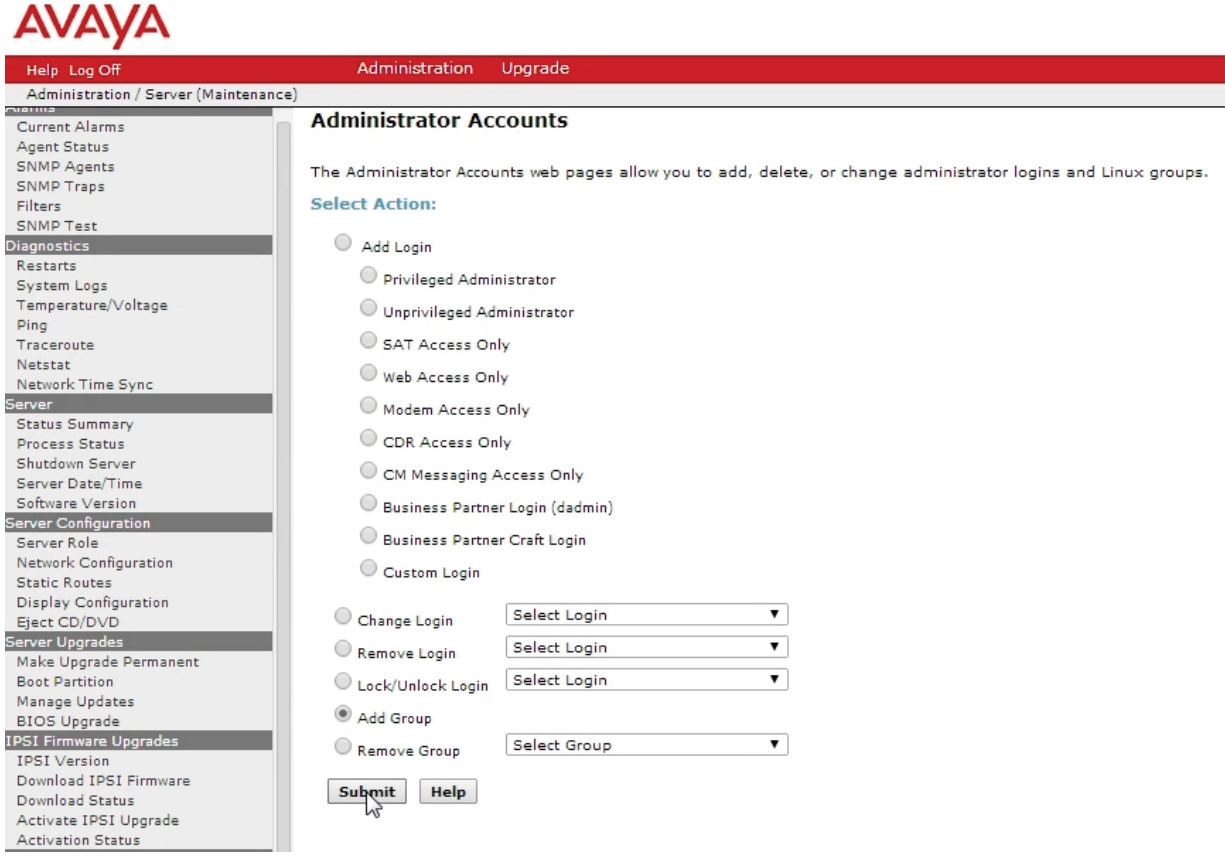
- In the Add a new access-profile group list, choose the profile number that matches the user profile you created earlier, then click Submit.
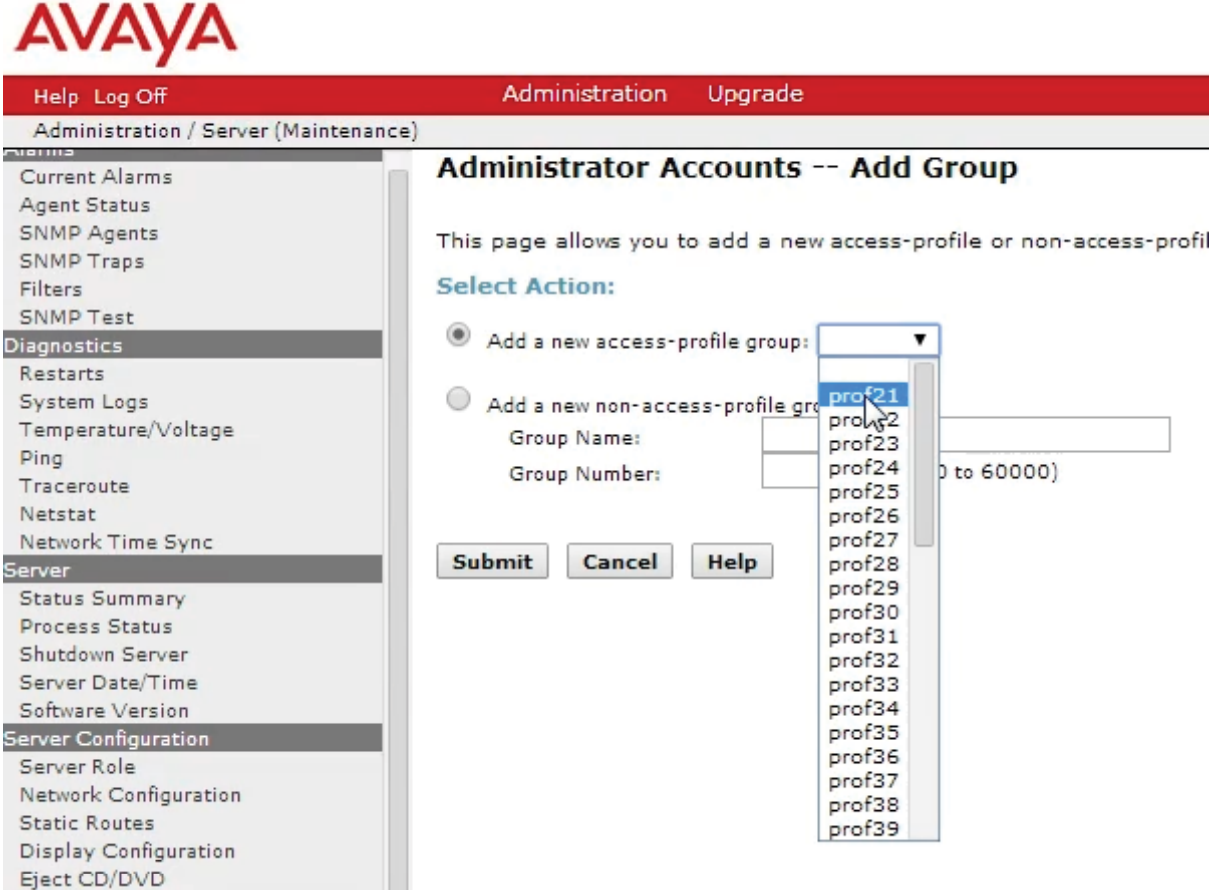
- Select SAT Access Only in the Add Login list on the Administrator Accounts page.
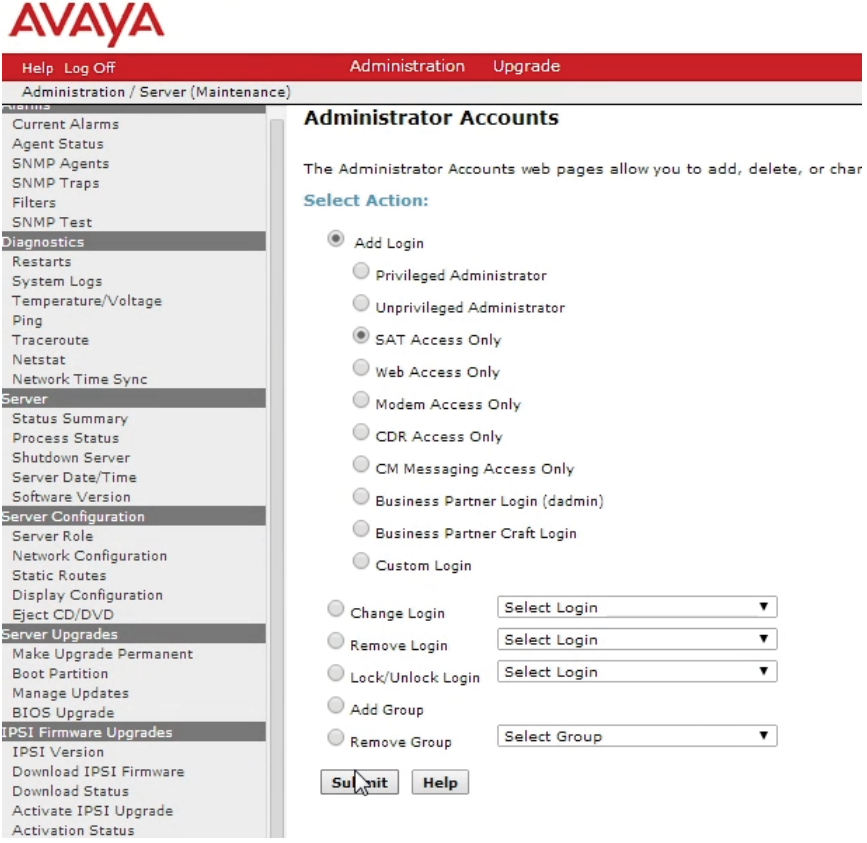
- Enter a login name, select users from the Primary group list, and choose the profile you created earlier from the Additional groups list. Create a password, then press Submit.
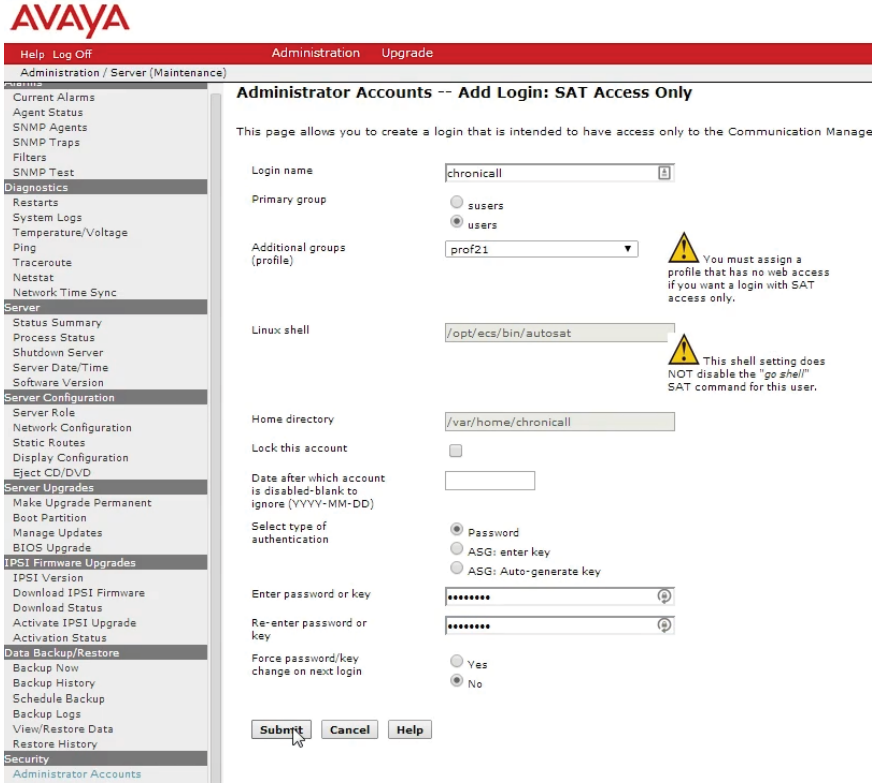
1.3 Configure CM to send CDR data
- If you are not using CDR Data, you can skip section 1.3.*
To configure the CM to send CDR data, do the following:
- Add the IP Address of the Chronicall server into the IP NODE NAMES. Type change node-names ip to access the node names and add the server Name and IP Address as shown below.
Please note, the example below uses xxx.xxx.xxx.xxx, however you will need to use an actual IP Address.

- Type change ip-services to setup a CDR link to the Chronicall Server using the following information:
The following information may be needed when setting up the Chronicall CDR service on the Chronicall server:
•Local Node is procr
•Remote Node: This is the Chronicall node you added in step 1.
•Service Type is CDR1
•Remote Port: This is the only information you will need when installing Chronicall.
number in this example is 9089 but can be any free port number (please make note
of the port number that you use)

- To configure the CDR Parameters, type change system-parameters cdr. Ensure all the fields are as shown below on Page 1 of system-parameters cdr. Note the Primary Output Endpoint is that of the service type added on Step two.
- Change the CDR Date Format to: month/day. Chronicall expects this date format to match this, and then you can change how it is presented to you on the reports within Chronicall. Continue to Page two for the next step.
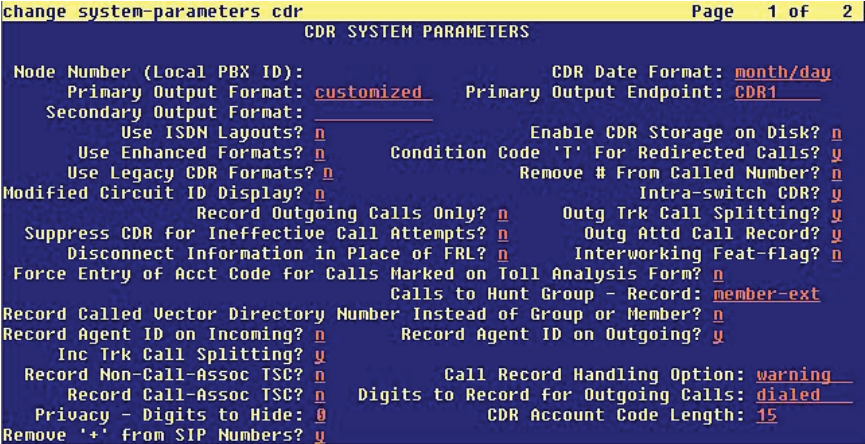
- Please ensure that all Data Item Length entries are the same as outlined below on Page 2 of system-parameters cdr. Items 35 – seq-num, and item 37 ucid are recommended but optional. In order to enable these features they need to be enabled by Avaya. Please open a ticket with Avaya and ask them to enable special application SA8702.
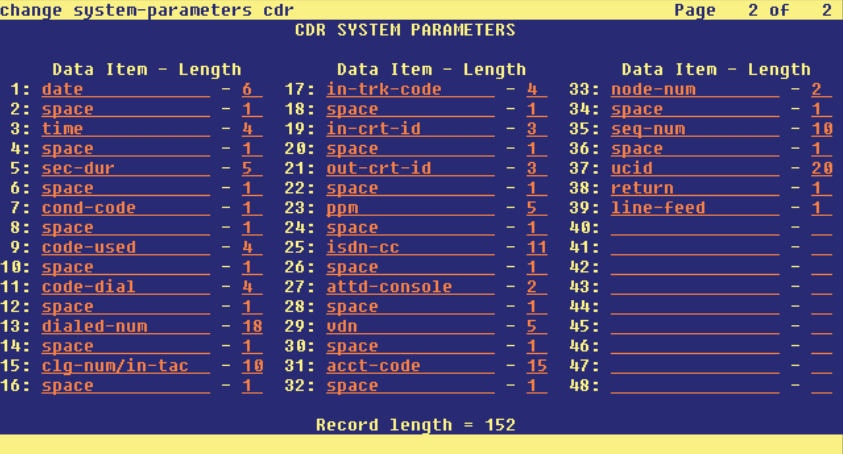
- Set CDR Reports to r in the trunk group used for outgoing/incoming calls to allow missed and internal calls to appear on the Chronicall CDR report.
- Type change trunk-group x where x is the number of the incoming/outgoing trunk group.
Please ensure that CDR Reports is set to r.

- Type change intra-switch-cdr to enable intra-switch calls to be reported and add the Extension numbers of the sets that are to be reported for internal calls.
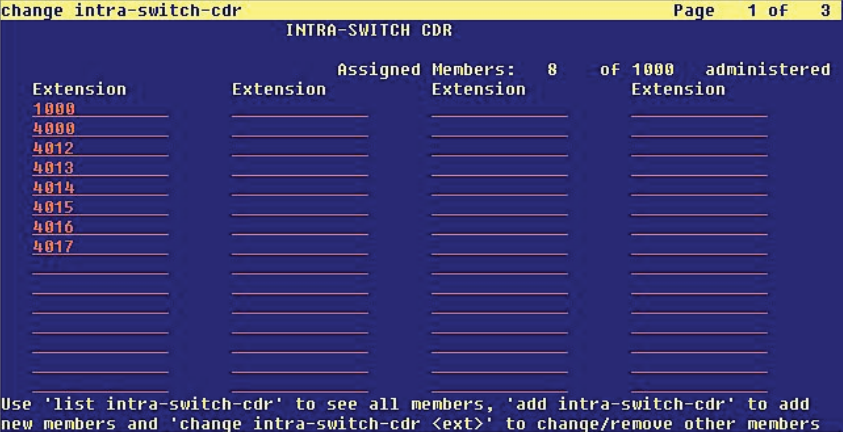
Section 1.4 - Exporting CM Stations, Users, Groups, VDN's, and Vectors for CDR Reporting
_If you are not using CDR for reporting, or if you have an AES Server you can skip section 1.4. The AES server can send Chronicall all the usernames and groups.
To Export, do the following:
- Please open a GEDI connection to your Communication Manager.
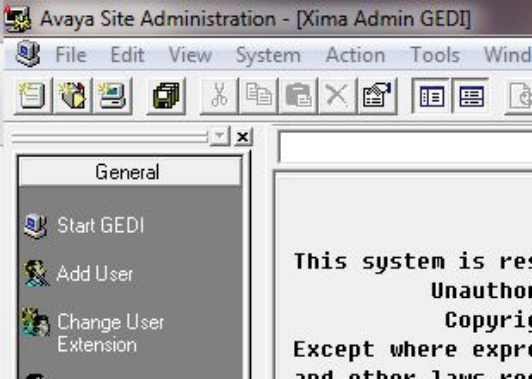
- Run a list command to query data.

- Go to File → Export

- Choose a location for the export file and hit OK. You'll want to put all of the exports in a directory together and name them well to make it easy to find them when Chronicall asks for them.
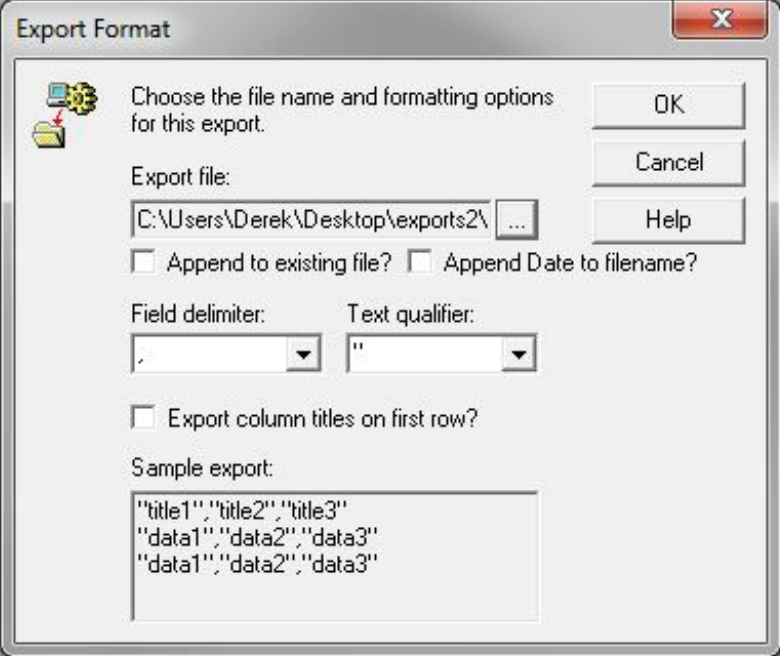
- You'll need to repeat these steps for each of the following commands, which will result in 5 files total.
list vdn
list vector
list hunt-group
list station
list agent-loginID
- During the Chronicall installation you will be asked to import these files. Again you don't need these files if you are using an AES Server.
Section 1.5 - Configuring the TSAPI CTI LINK
- To add the CTI Link, Type add cti-link x command, where x is a number between 1 and 64. Enter a valid extension number under the provisioned dial plan. Set the Typ Field to ADJ-IP and assign a descriptive Name to the CTI LINK. Defaul values may be used in the remaining fields.

- To enter the node name, type change node-names ip In the compliance-tested configuration, the CLAN IP address was utilized for registering H.323 endpoints (Avaya IP Telephones, Avaya IP Agents, and Avaya AES DMCC stations). The CLAN-AES IP address was used for connectivity to the Avaya AES server. Please note if you are configuring the AES to connect to an S8300 the IP Address needs to be the same IP as your processor.

- To change the IP service, type change ip-services On Page 1, configure the Service Type field to AESVCS and the Enabled field to y. The Local Node field should be pointed to the CLANAES board that was configured previously in the node-name ip form. During the compliance test, the default port was utilized for the Local Port field.

- Now go to Page 3, to continue the IP service change. Configure the Service Type field to aesxima and the Enabled field to y. This password is used in step 7 in this section so make note of it.

- Log into the AES web Interface.

- For adding a new connection, select Communication Manager Interface and add new connection.

- The next page will prompt you to enter a password. If your processor is already configured please proceed to next step. You will need to enter the switch password that you configured in step 4 if not.

- Out next step will be to add CLAN to AES. After returning to the Switch Connections page, select the radio button corresponding to the switch connection added previously, and click on Edit CLAN IPs. Enter the IP address of the CLAN used for Avaya AES connectivity from Section 3.6, and click on Add Name or IP.

- Your Communication Manager will now be able to communicate with your AES Server.
Section 1.6 - Configure AES Server
- You will also need to set up an AES user. You can do this by accessing the Management Console on the AES server. In a web browser, navigate to http://[AES server IP address] and log in.

- Log in and expand the AE Services section at the top of the sidebar to the left, followed by TSAPI, then TSAPI Links. Make sure the TSAPI link is selected and select Edit. Change the ASAI Link Version to 5 and apply the changes. Please note that the ASAI link needs to be version 5 or above.
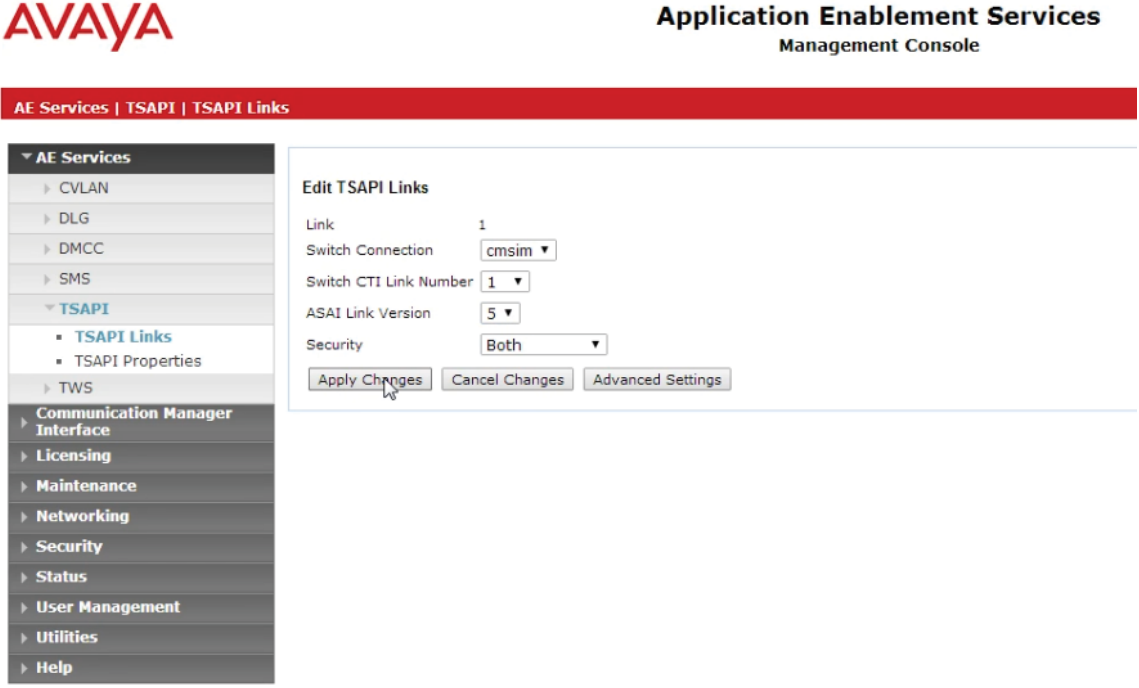
- Under User Management, open User Admin and select Add User. Give the new user a name and a password. Change the CT User option to Yes, then scroll down and press Apply.
Special Note – for the password alphanumeric is accepted and the following special characters . , @ $
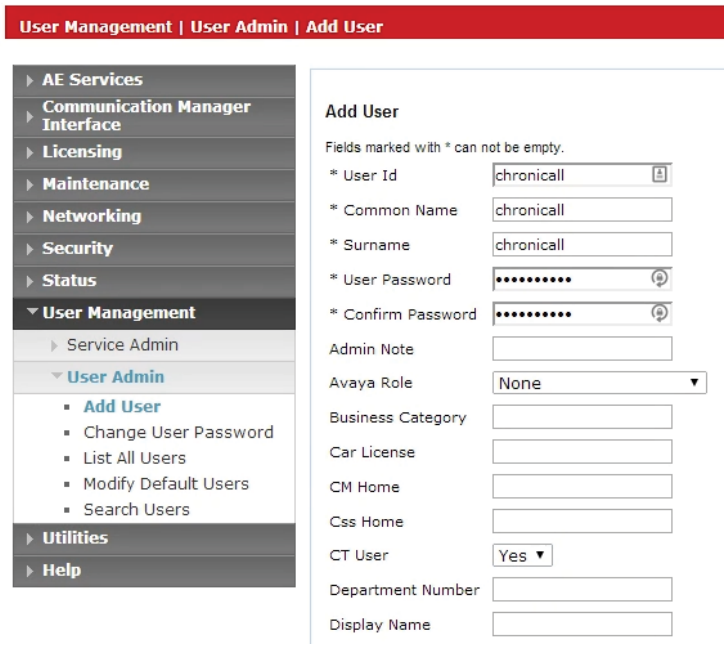
- You may also need to enable SDB for TSAPI Service, JTAPI and Telephony Web Services under Security, Security Database, Control.

- Expand the CTI Users section next to the Control Link and select List All Users. Select the Chronicall user and select Edit. Instead of giving this user specific access privileges, select the Unrestricted Access box. Chronicall itself will handle the appropriate access permissions.
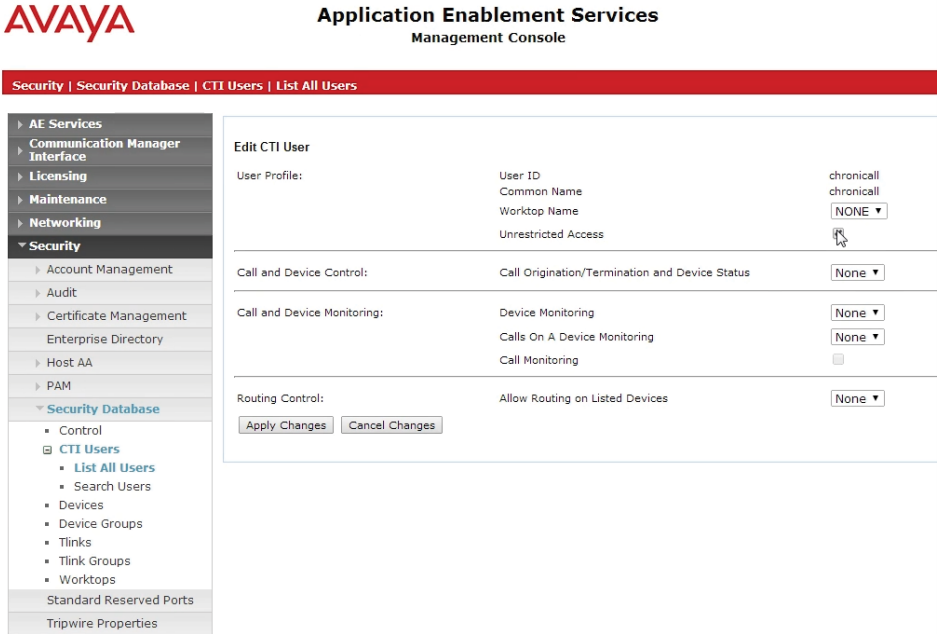
- For future reference, you will want to copy the first Tlink under Security, Security Database, Tlinks, and paste it somewhere it will be easy to access later.

- WARNING, Do not do try this step unless your system isn't live or it is after hours. This will drop all phone calls in the system if you do this step on a live PBX system. Under Maintenance, open the Service Controller. Here, you will need to select TSAPI Service and click Restart Service.
Section 2.1 - Xima Chronicall CM Installation
- The final step is to download and install Chronicall once CM has been properly configured. Visit our downloads page at Chronicall Downloads and enter your serial key to access file downloads. If you have a serial and don't know it, you can find your serial key under Help > About Chronicall. If you do not have a serial key, visit Xima Trials or talk to your Xima re-seller.
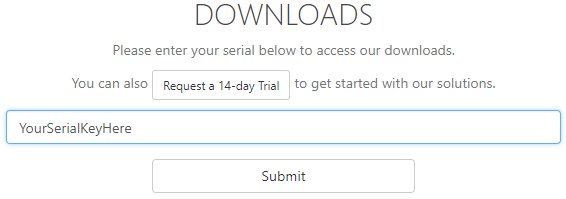
- Once you have downloaded the Chronicall installer, run it and follow the installation
instructions as given. The most current version of Oracle's JVM is required for installation of Chronicall for 3.9.4 and under. For 3.9.5 and above Java is built into Chronicall.
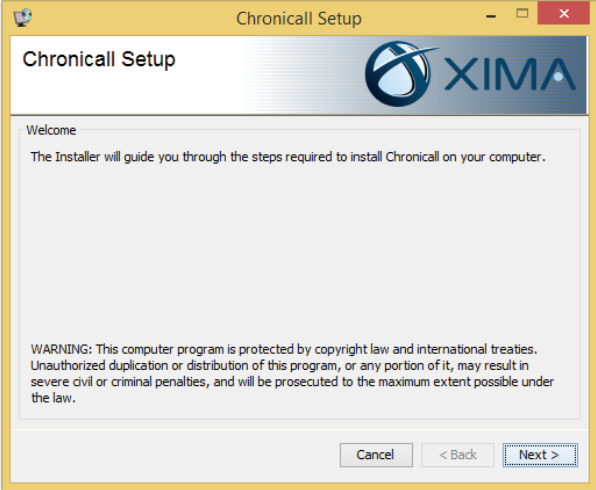
- Read the License Agreement. You must accept the terms of this agreement before continuing with the installation.

- Chronicall will be installed in the folder shown and defaults to the C: drive. To change where Chronicall is installed, enter the file path or click Browse.
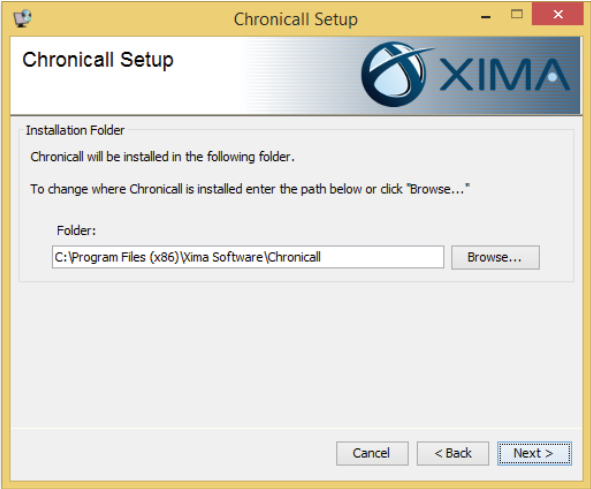
- Chronicall will only log when it is able to verify its registration with Xima Software. Please
enter your serial key below to register Chronicall.
Chronicall can optionally be installed in Demo Mode, which allows you to use the software without a connection to a phone system. Demo Mode is used by authorized Xima Partners who need to demonstrate Chronicall without a phone system.
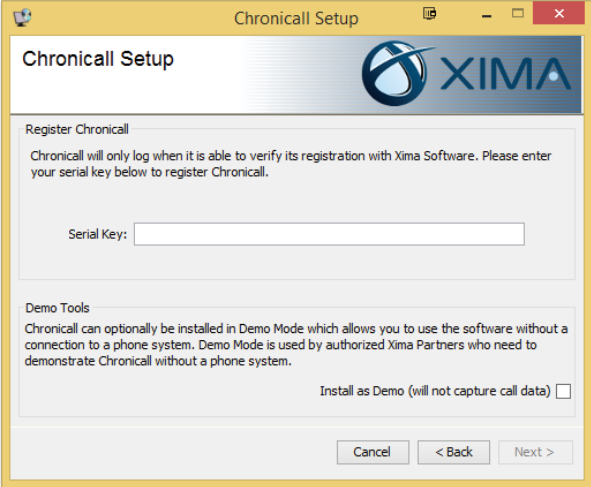
- Chronicall stores its data in a PostgreSQL database. Indicate which port PostgreSQL
should use to communication with other applications. A database user will be created
with the credentials listed.
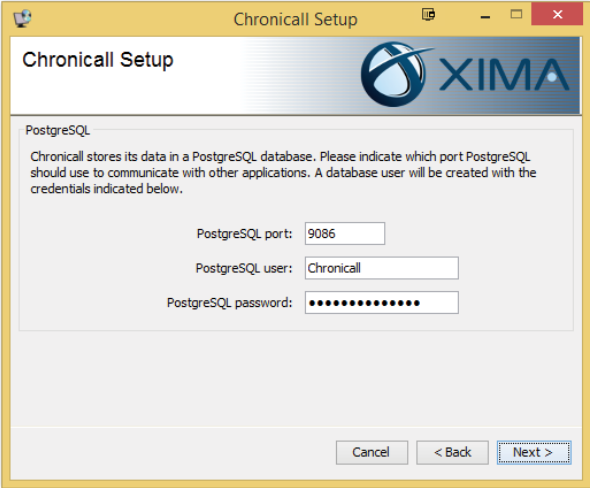
- Chronicall is accessed through a web interface served by Apache Tomcat. Please make
sure no other applications are using the Tomcat port as you will be unable to access
Chronicall if this port is not free.
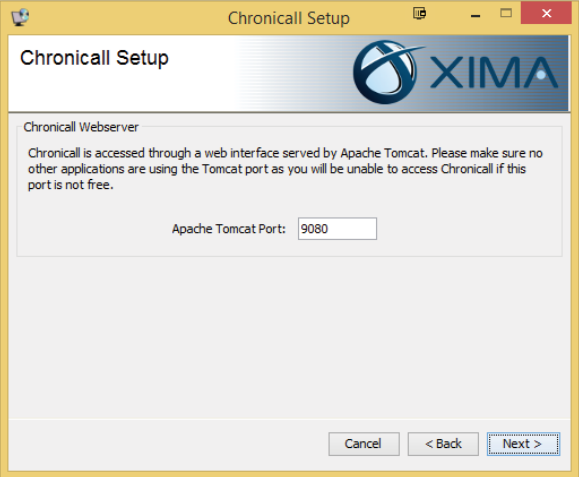
- If your customer purchased Recording Library it will ask if you would like to Install the
Recording Library Service. If this is the PC where the recordings will be stored please
select “yes”.
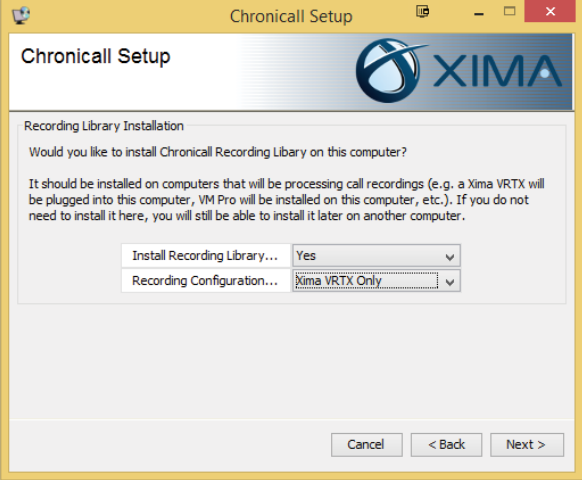
- If this is not the PC where the recordings will be stored it will ask you to copy a URL that
you can use to install the Recording Library software on the storage PC.
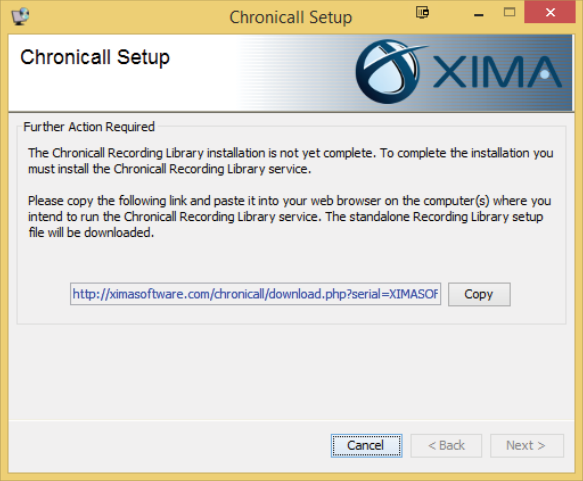
- Once you reach this screen, the installer has all of the information necessary to begin
installation. To begin, click the Install button.
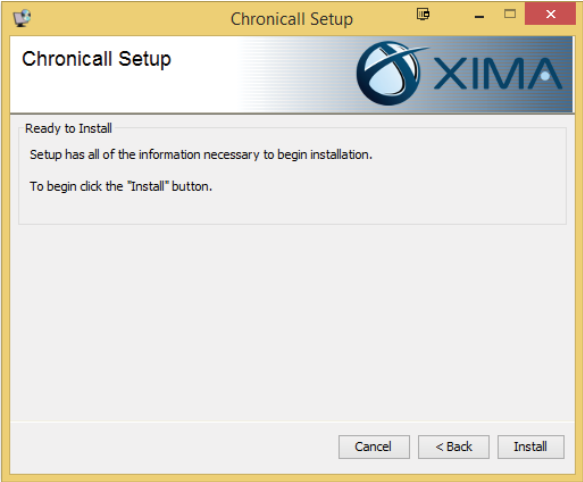
- A progress bar will be displayed while Chronicall is installed.
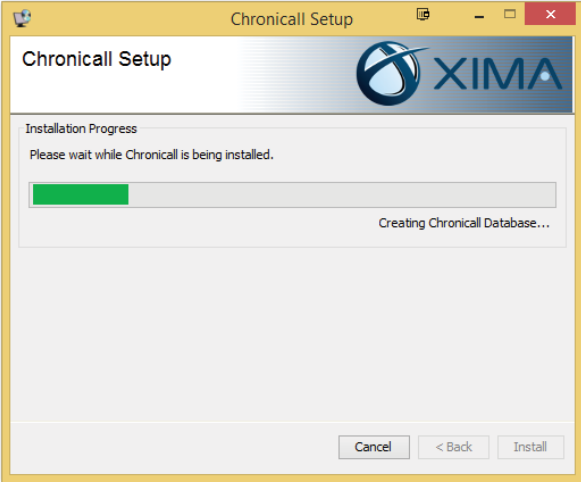
- When the installation is finished, copy or bookmark the web address given to you. This is
how you will access Chronicall.
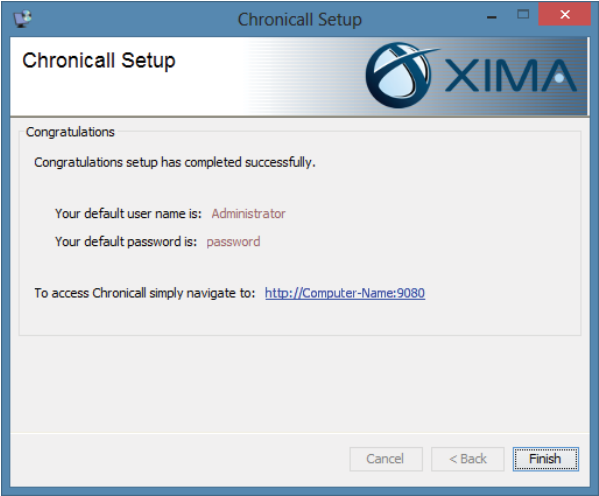
- Open Chronicall. The default user login is Administrator, and the password is password.
These can be changed later.

- The first time you open the Chronicall web client, you will be presented with a short setup
wizard that will help you connect your phone system and choose agents for Realtime and
Agent Dashboards functions. You can skip this setup process by clicking Skip in the
bottom right corner of the Chronicall window, but it will reappear the next time you use
Chronicall.
Are you going to use TSAPI licenses to log additional details? If yes, select Use TSAPI. If
no, select Do Not use TSAPI.

- If you Select yes, please follow the next step. If you selected no, please proceed to CDR only installation.
The first time you open the Chronicall web client, you will be presented with a short setup wizard that will help you connect your phone system and choose agents for Realtime and Agent Dashboards functions. You can skip this setup process by clicking Skip in the bottom right corner of the Chronicall window, but it will reappear the next time you use Chronicall.
- Enter your AES and CM server information. Hitting next will verify that your CM user is
created and has necessary access. After your CM user is verified it will download information
including your users and groups which may take a couple of minutes.
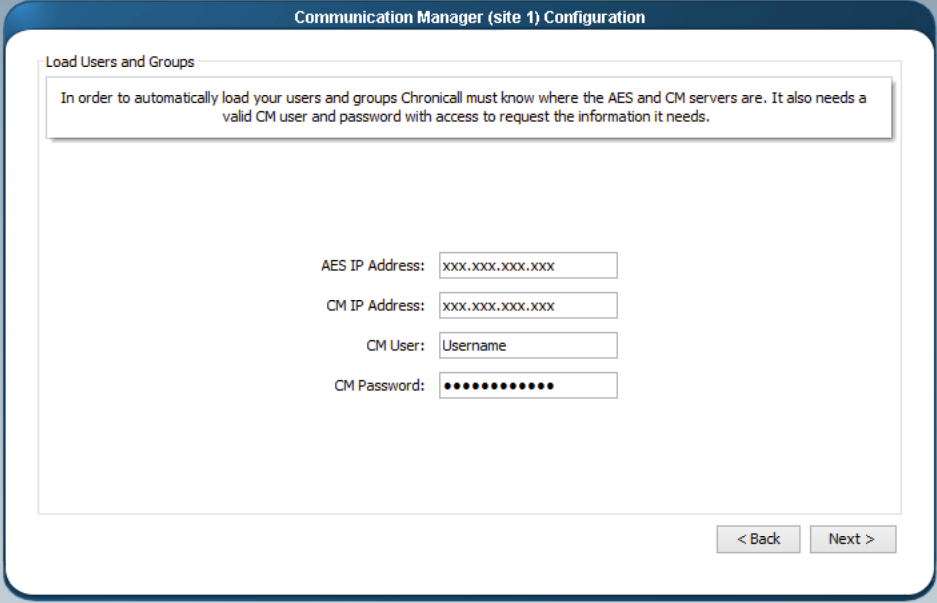
- Enter the requested TSAPI and AES information. Hitting next will verify that your AES user
is created and has necessary access.
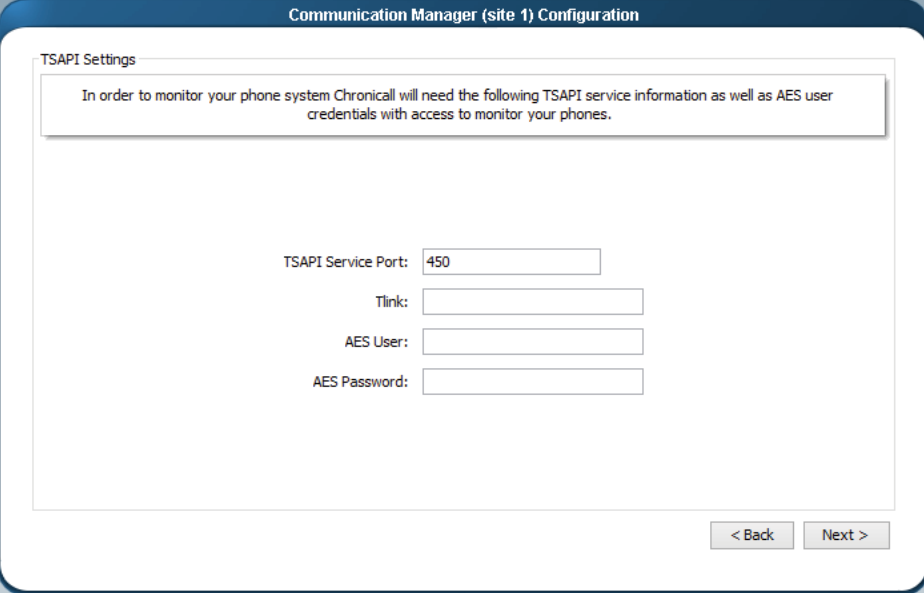
- Enter which stations, and agents you would like to log data for within Chronicall.

- Set a number of max TSAPI licenses and check the boxes for the stations and skills you
would like to monitor. Please note, that if you don't assign a TSAPI license to a station or
agent, they will default to CDR logging. Logging both TSAPI and CDR is possible.

- Select the hunt group you use for voicemail.
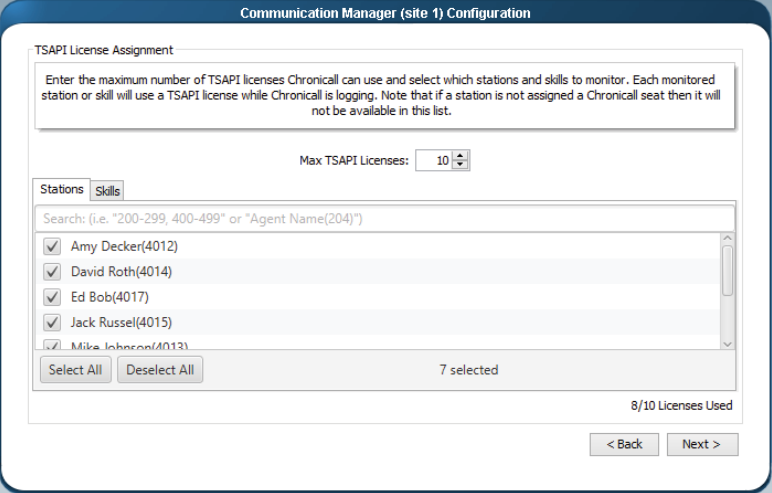
- On this screen, you can enter information about your AUX Work states and reason codes.
Select Add to add a new reason code.
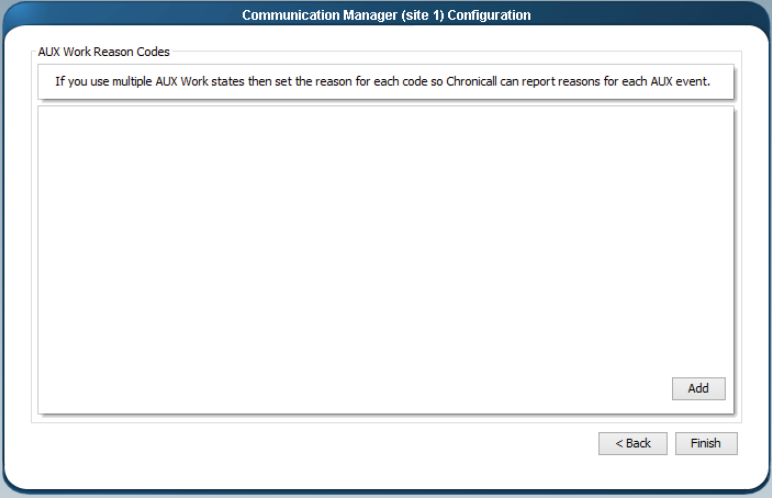
- Choose a code number and name for each reason code, then press OK.

- On this screen, choose the users you would like to monitor with Realtime.
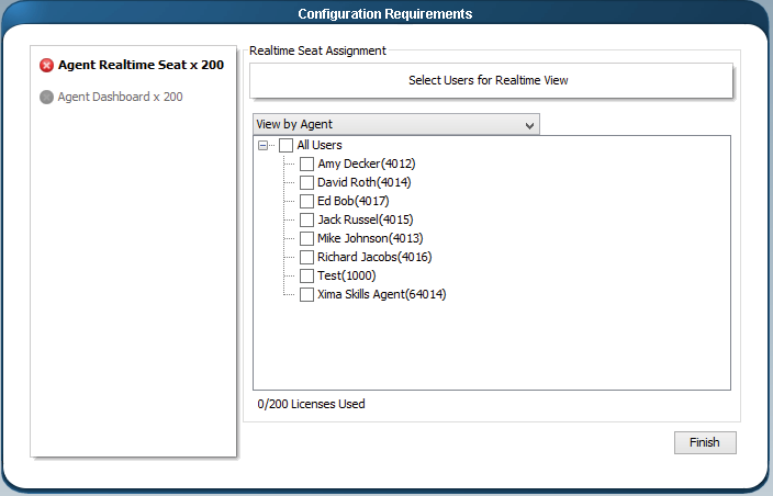
- On this screen, choose the users you would like to monitor with Dashboards.
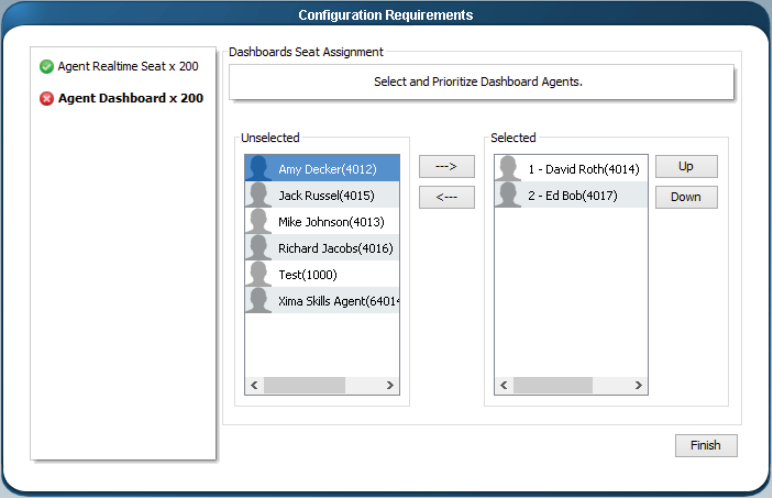
Section 2.2 - CDR Installation instructions
- If you are logging data with an AES server please select Do no use TSAPI.
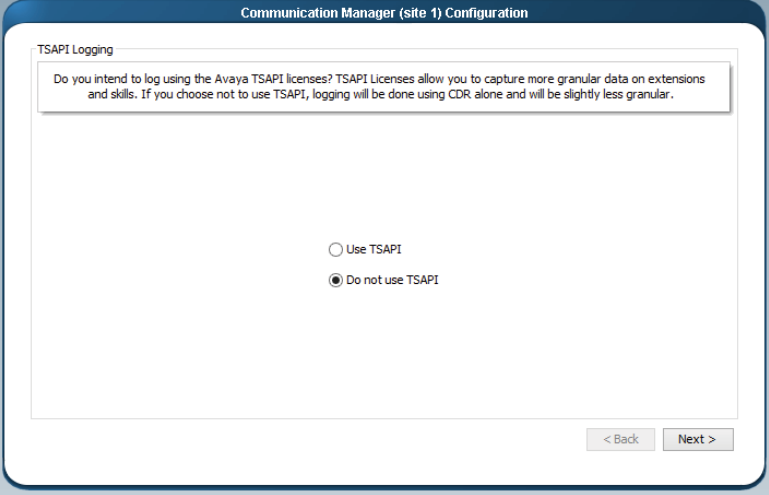
- Enter your AES and CM server information. Hitting next will verify that your CM user is created and has necessary access. After your CM user is verified it will download information including your users and groups which may take a couple of minutes. If you do not have an AES server, please click Import Configuration Manually to import your users and groups.
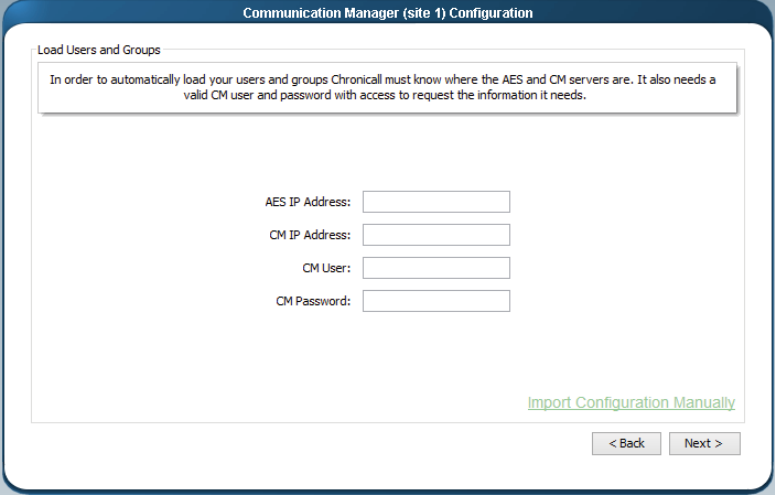
- You will need to import each of the files listed below in order to categorize the database
with the CDR records.

- Each file should be imported as a .txt file.
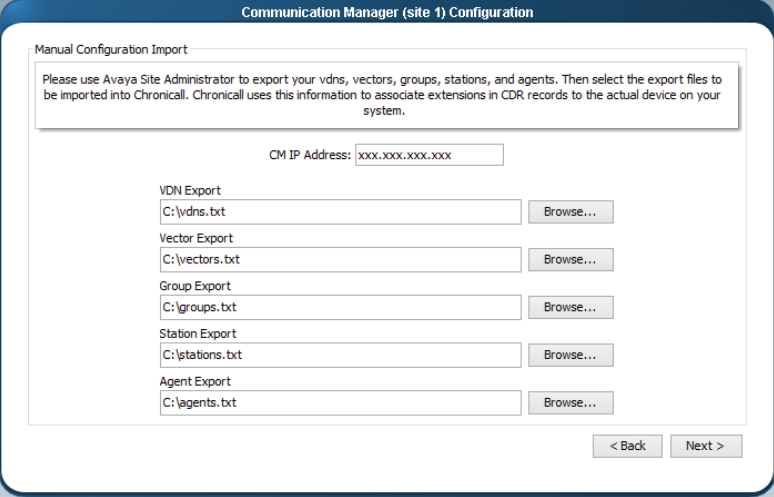
- Please select which users receive a Chronicall logging license.
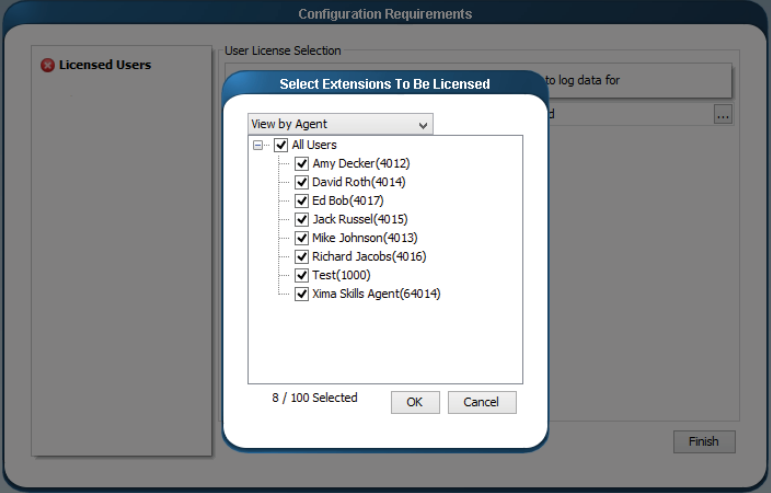
- You have finished installing Chronicall.
Press Finish and you will be taken to the main Chronicall interface. Visit our support site at
Xima Support for additional information.
Changing the Language
Before Changing the LanguageWhen changing the language, the list of Chronicall Standard Reports will not switch to the new language. Rather, the existing English reports will stay and the new language counterparts will be added to the list. In other words, your list of reports will contain each report in English and a duplicate report in the selected new language.
If you don't want the English version of the reports to remain, you can delete all existing English reports before doing the language download. Simply select all reports in Standard Reports, right click, and select "Delete."
When changing the language, the list of Chronicall Standard Reports will not switch to the new language. Rather, the existing English reports will stay and the new language counterparts will be added to the list. In other words, your list of reports will contain each report in English and a duplicate report in the selected new language.
If you don't want the English version of the reports to remain, you can delete all existing English reports before doing the language download. Simply select all reports in Standard Reports, right click, and select "Delete."
A Note on the Realtime WallboardsIf any Realtime wallboards have been created prior to the download of the new language, the previously created wallboards will remain in English. However, any wallboards created after the language download has been performed will be presented with the downloaded language.
Updated 2 months ago